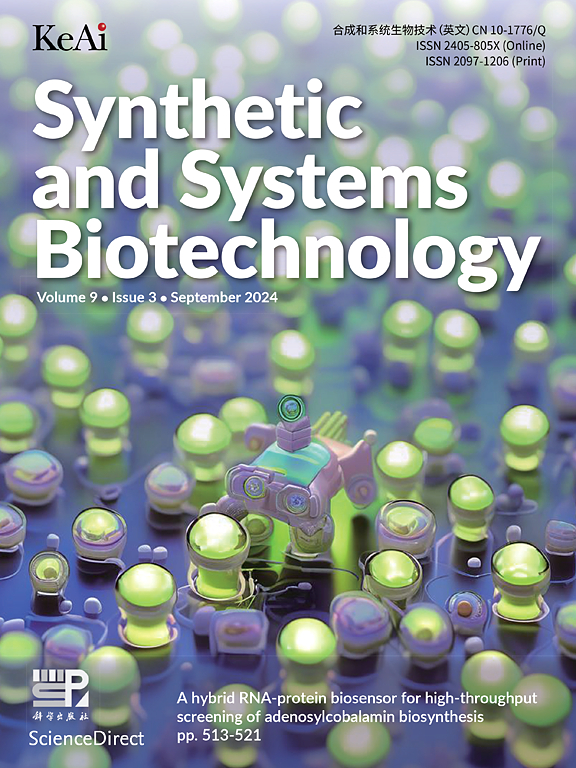Enhancing 3-hydroxypropionic acid production from recombinant Saccharomyces cerevisiae for using rice straw hydrolysate and sugar cane industrial waste as substrate
IF 4.4
2区 生物学
Q1 BIOTECHNOLOGY & APPLIED MICROBIOLOGY
引用次数: 0
Abstract
Rice straw and sugar cane industrial waste are a plentiful source of lignocellulosic biomass with a high polysaccharide content, that is hydrolyzed into sugar for microbial growth and their metabolites. 3-Hydroxypropionic acid (3-HP) is a promising chemical building block that can be produced from renewable resources. The malonyl-CoA pathway is one of the biosynthetic routes for 3-HP production by expressing the malonyl-CoA reductase gene (mcr). However, the problem of the activity imbalance between the C and N-terminal causes a low conversion rate of malonyl-CoA to 3-hydroxypropionic acid. This study aimed to balance the bi-functional MCR enzyme by dissecting MCR into two fragments and enhancing the supply of intermediates to increase the production of 3-HP. The recombinant strain harboring the dissected mcr gene showed a 21-fold increase in 3-HP titer compared to the strain carrying the full-length mcr gene. The addition of cerulenin and acetate to the fermented medium enhanced 3-HP yield by 8 times, in which recombinant yeast produced 3-HP up to 10 g/L (0.201 gproduct/gsubstrate). The results of using rice straw hydrolysate as a carbon source indicated that Saccharomyces cerevisiae S2 produced 3-HP of 4.02 g/L, which was 0.074 gproduct/gglucose in the diluted hydrolysate. These findings provide an alternative and sustainable strategy for utilizing lignocellulosic biomass for future 3-HP production at an industrial scale.
以水稻秸秆水解液和甘蔗工业废料为底物,提高重组酿酒酵母生产3-羟基丙酸的能力
水稻秸秆和甘蔗工业废料是木质纤维素生物质的丰富来源,多糖含量高,可水解成糖供微生物生长及其代谢产物。3-羟基丙酸(3-HP)是一种很有前途的化学原料,可以从可再生资源中生产。丙二酰辅酶a途径是通过表达丙二酰辅酶a还原酶基因(mcr)产生3-HP的生物合成途径之一。然而,C端和n端活性不平衡的问题导致丙二酰辅酶a转化为3-羟基丙酸的转化率较低。本研究旨在平衡双功能MCR酶,将MCR分解为两个片段,并增加中间体的供应,以增加3-HP的产量。与携带全长mcr基因的菌株相比,携带分离mcr基因的重组菌株的3-HP滴度提高了21倍。在发酵培养基中添加蓝蓝蛋白和醋酸盐可使3-HP产量提高8倍,其中重组酵母的3-HP产量高达10 g/L (0.201 g产物/g底物)。以稻秆水解液为碳源的结果表明,酿酒酵母S2的3-HP为4.02 g/L,稀释后的水解液为0.074 g/葡萄糖。这些发现为利用木质纤维素生物质在未来的工业规模上生产3马力的产品提供了一种替代和可持续的策略。
本文章由计算机程序翻译,如有差异,请以英文原文为准。
求助全文
约1分钟内获得全文
求助全文
来源期刊

Synthetic and Systems Biotechnology
BIOTECHNOLOGY & APPLIED MICROBIOLOGY-
CiteScore
6.90
自引率
12.50%
发文量
90
审稿时长
67 days
期刊介绍:
Synthetic and Systems Biotechnology aims to promote the communication of original research in synthetic and systems biology, with strong emphasis on applications towards biotechnology. This journal is a quarterly peer-reviewed journal led by Editor-in-Chief Lixin Zhang. The journal publishes high-quality research; focusing on integrative approaches to enable the understanding and design of biological systems, and research to develop the application of systems and synthetic biology to natural systems. This journal will publish Articles, Short notes, Methods, Mini Reviews, Commentary and Conference reviews.
 求助内容:
求助内容: 应助结果提醒方式:
应助结果提醒方式:


